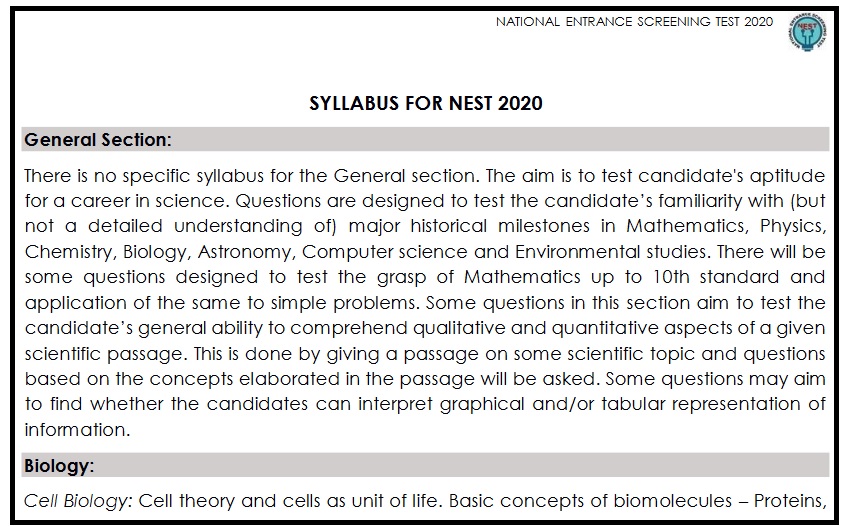NEST Syllabus 2020 National Entrance Screening Test : nestexam.in
Organisation : NISER, Bhubaneswar and UM-DAE CEBS, Mumbai
Exam Name : NEST 2020 National Entrance Screening Test
Facility Name : NEST Syllabus 2020
Website : https://www.nestexam.in/
NEST Exam
National Entrance Screening Test (NEST) is a compulsory test for students seeking admission to National Institute of Science Education and Research (NISER) Bhubaneswar and University of Mumbai – Department of Atomic Energy Centre for Excellence in Basic Sciences (UM-DAE CEBS), Mumbai.
Related / Similar Syllabus : NEST Syllabus 2021

NEST 2020 will be conducted in around 90 cities across India.
NEST Syllabus
General Section:
There is no specific syllabus for the General section. The aim is to test candidate’s aptitude for a career in science. Questions are designed to test the candidate’s familiarity with (but not a detailed understanding of) major historical milestones in Mathematics, Physics, Chemistry, Biology, Astronomy, Computer science and Environmental studies.
There will be some questions designed to test the grasp of Mathematics up to 10th standard and application of the same to simple problems. Some questions in this section aim to test the candidate’s general ability to comprehend qualitative and quantitative aspects of a given scientific passage.
This is done by giving a passage on some scientific topic and questions based on the concepts elaborated in the passage will be asked. Some questions may aim to find whether the candidates can interpret graphical and/or tabular representation of information.
Biology:
Cell Biology:
Cell theory and cells as unit of life. Basic concepts of biomolecules – Proteins, Carbohydrates, Lipids, Nucleic acids. Tools and techniques of cell studies – use of microscope and calibration (microscopy), elements of microscope. Biomembranes – transport mechanism, cellular respiration.
Cell organelles – structure and functions. Discovery and structure of DNA, processes of replication, transcription, genetic code and translation. Principles of the basic techniques in molecular biology. Enzymes– catalysis, kinetics, activation energy, competitive and non– competitive inhibition.
Genetics and Evolution:
Fundamentals of genetics and evolution. Evidences and theories of organic evolution. Organization of the heredity material in chromosomes. Equational division. Reduction division. Mitosis and meiosis compared and contrasted. Significance of meiosis. Mendel’s laws of inheritance.
Discovery of linkage, sex–linked inheritance. Crossing– over, stage at which crossing– over occurs. Neurospora genetics. Mutation – discovery, types of Mutation and Mutations in diploids. Role of mutations in evolution. Elaboration of Mendel’s laws of inheritance. Monohybrid or Dihybrid crosses. Human genetics – human chromosomes, sex–determination, sex–linked inheritance.
Ecology:
Physical and biological factors in influencing organisms. Food chains, pyramids of numbers and biomass. Biological equilibrium. Interspecific associations. Bio–diversity. Flora and fauna. Basics of microbial systems, Ecosystems.
Humans and Environment:
Soil, rainfall and temperature with reference to natural resources. Our natural resources – their uses and abuses. Environmental pollution and preventive measures. Biodiversity and conservation.

Biotechnology:
Principles of recombinant DNA technology. Applications of biotechnology.
Biology of Animal systems:
** Digestive System – Modes of nutrition.
** Different vitamin compounds and their deficiencies.
** Structure of alimentary canal and associated glands, digestive enzymes and gastrointestinal hormones.
** Absorption of products of digestion, peristalsis, balanced diet. Respiratory System – Gaseous exchange in animals.
** Structure of respiratory organs, mechanism of breathing, gaseous transport, tissue respiration.
** Circulatory System – Open and closed systems. Functions of blood and 1ymph. Microscopic structure of blood and blood vessels.
** Structures and working of heart. Distribution of arteries and veins. Circulation of blood coagulation. Blood groups.
** Excretory System – Elimination of nitrogenous waste. Osmoconformers and osmoregulators. Structure and function of kidney tubules. Arrangement of excretory organs.
** Nervous System – General account of brain, spinal cord and nerves. Re ex actions (simple and conditioned). Sense organs (eye and ear).
** Reproductive System – Sexual and asexual reproduction. General arrangement and functions of reproductive organs.
Developmental Biology:
Basic features of development in animals. Types of eggs, fertilization, cleavage, blastula. Stem cells– definition, types, uses, advantages and disadvantages, induced pluripotent stem cells. Different hormones and their roles.
Diversity of Animal Life — Principles of classification, binomial nomenclature. General classification of animal phyla up to classes (invertebrates) and up to sub–classes / order (vertebrates), General characters of fishes, amphibians, reptiles, birds and mammals.
Immunology:
Basics of immune mechanisms and diseases– active and passive immunity, T- and B-cell responses, antigen presentation, principles of vaccination, monoclonal antibodies and their uses, immunology of AIDS.
Biology of Plant systems:
Anatomy and Physiology of Plants – Meristems. Plant growth and development. Internal and external regulators of growth and development in plant. Plant reproduction. Internal structure of root, stem, secondary growth and leaves. Xylem and Phloem – their cell elements and functions.
Internal structure of dicot and monocot leaves. Photosynthesis – history, importance, factors and mechanism, stomatal mechanism, transpiration and respiration. Comparative study of dicot and monocot anatomy.
Absorption and cell–water relations, transport of water and minerals, tropic and turgor movements. Significance of life–cycles with special reference to alternation of generations as exemplified in Funaria, Selaginella and Pinus (no structural details). Plant hormones.
Systematics:
Principles of classical and new systematics. Binomial nomenclature. Familiarity with taxa. Plant breeding and tissue culture.
Important Downloads
NEST 2020 Syllabus : http://www.syllabus.gen.in/uploads/pdf2020/1690-syllabus.pdf